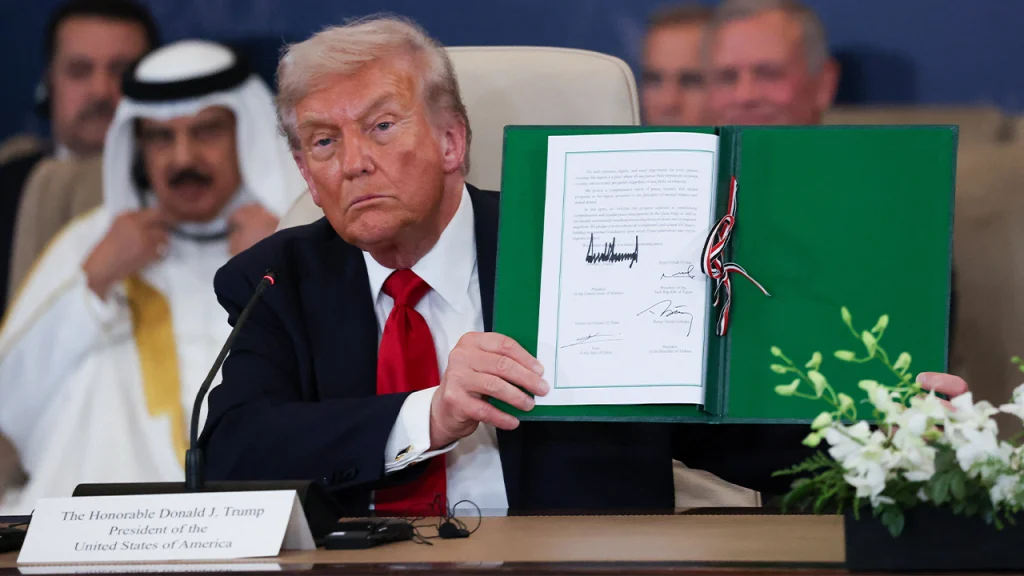Trump Warns Hamas as Vance Plans Israel Visit Amid Fragile Ceasefire
President Donald Trump delivered a stark warning to Hamas during a White House meeting with Australian Prime Minister Anthony Albanese, emphasizing that the U.S.-brokered Gaza truce must remain intact. “We’re going to eradicate them. If we have to, they’ll be eradicated. And they know that,” Trump stated firmly, highlighting the broad international support for the deal which includes “59 countries.” This warning comes as Vice President JD Vance prepares to visit Israel, though specific details of his trip have yet to be announced. The diplomatic effort extends beyond Jerusalem, with U.S. envoys Steve Witkoff and Jared Kushner expected to travel to Egypt from Israel for discussions with Hamas representatives, signaling a push to transition from maintaining the ceasefire to negotiating the more challenging next phase of the peace process.
When questioned about potential U.S. military involvement, Trump clarified that his administration does not plan to deploy American troops, noting that other nations—and Israel itself—could act if necessary. “We don’t need to, because we have many countries, as you know, signed on to this deal,” he explained. “We’ve had countries calling me when they saw some of the killing with Hamas, saying we’d love to go in and take care of the situation ourselves. In addition, you have Israel—they would go in, in two minutes.” Trump’s measured approach suggests giving peace a chance while maintaining a position of strength, adding pointedly that Hamas “has to be good, and if they’re not good, they’ll be eradicated—because absolutely we can, and we have the capacity to do so.” He also noted that Hamas now lacks Iranian backing, potentially weakening their position.
The president’s comments come at a critical moment following a weekend flare-up where Hamas terrorists killed two Israeli soldiers, prompting retaliatory Israeli strikes. Despite this violence, both Israel and Hamas have publicly recommitted to the Trump-brokered 20-step ceasefire plan. On the ground, practical implementation continues as the Israeli Defense Forces (IDF) took custody of another deceased hostage’s remains, requesting public sensitivity during the identification process. Israeli officials indicate that Hamas could immediately return six more bodies from the 15 still believed to be in Gaza, though some remains may be unrecoverable due to widespread destruction in the area.
Meanwhile, Israeli Prime Minister Benjamin Netanyahu addressed the Knesset with a firm stance, warning that the fighting was far from over and that violations of the ceasefire would carry a “very heavy price.” Despite this hardline position, Netanyahu praised the “unprecedented closeness” with Washington, underscoring the strong coordination between the U.S. and Israel during this delicate phase. The diplomatic relationship appears stronger than ever as both nations work toward implementing the complex peace arrangement while remaining vigilant against potential violations from Hamas.
As part of the ceasefire implementation, the IDF’s Southern Command has begun establishing a physical demarcation inside Gaza—placing 3.5-meter concrete barriers topped by yellow poles approximately every 200 meters. This “yellow line” is designed to create “tactical clarity on the ground” as stipulated in the ceasefire arrangement. The military indicated that this marking process will continue “in the coming period” as forces work to remove threats and protect Israeli civilians, representing a tangible step toward creating the conditions necessary for a lasting peace.
The situation remains tenuous but hopeful as diplomatic efforts intensify on multiple fronts. Vice President Vance’s upcoming visit to Israel, coupled with Witkoff and Kushner’s negotiations in Egypt, demonstrates the Trump administration’s comprehensive approach to securing the ceasefire and moving toward a more permanent resolution. While challenges remain—particularly regarding the return of hostages and maintaining calm on the ground—the current diplomatic framework represents the most promising path toward ending the two-year conflict. Trump’s combination of diplomatic engagement and clear warnings to Hamas illustrates his administration’s strategy: offering peace while maintaining the credible threat of overwhelming force should the terrorist group fail to comply with the agreement’s terms.


